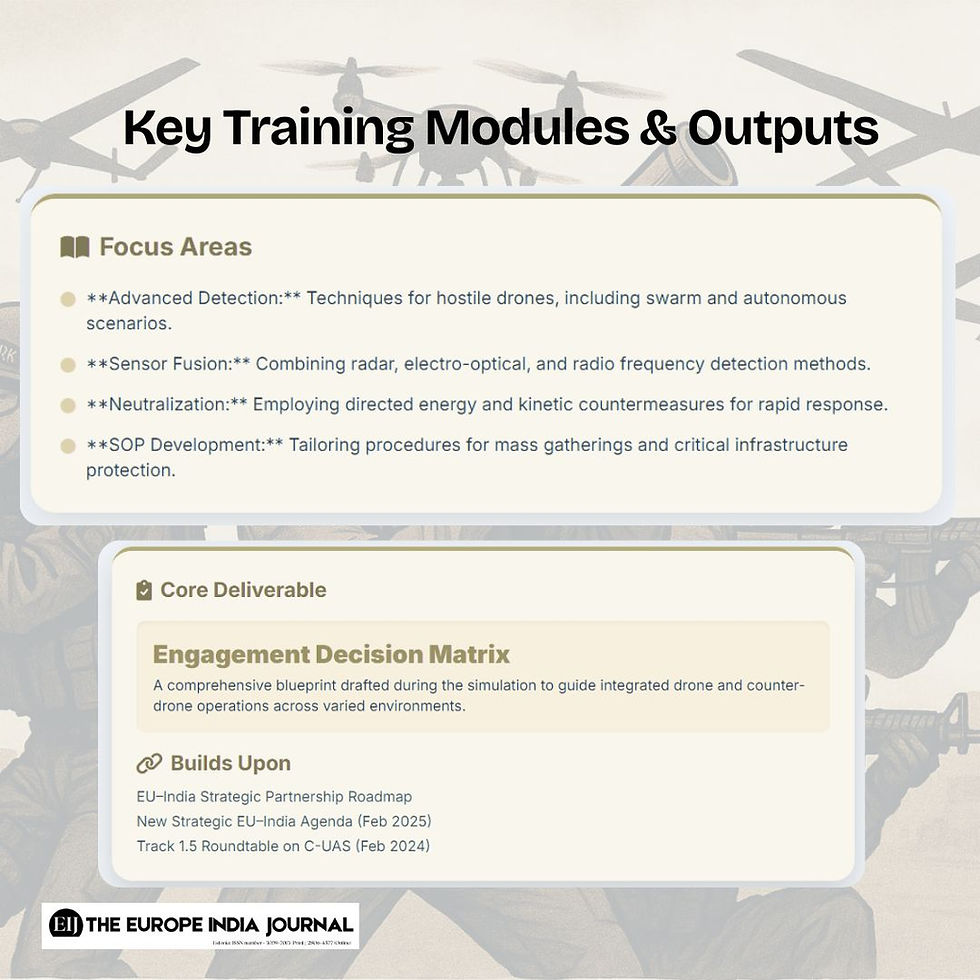EU–India Joint Counter-UAS Training: A New Security Milestone
- News Desk

- Oct 17
- 2 min read
The three-day EU–India Joint Counter-UAS Training held from 13 to 15 October 2025 in Manesar, Gurugram represents a significant advancement in bilateral security cooperation. By bringing together the European Union’s High Risk Security Network (HRSN) and India’s National Security Guard (NSG), the exercise underscores both partners’ commitment to countering evolving unmanned aerial systems (UAS) threats and enhancing joint readiness for critical infrastructure protection.
Counterterrorism Training Overview

Hosted by the EU Delegation to India in collaboration with India’s Ministry of Home Affairs, the training focused on real-world tactical and technological scenarios. Senior officers, instructors, and technical experts from 21 EU Member States’ specialized HRSN units worked alongside NSG personnel. This peer-to-peer format combined classroom instruction, hands-on demonstrations, and a full-scale tactical simulation to strengthen interoperability in UAS and counter-UAS (C-UAS) operations.
EU–India Collaboration Framework
This event builds on the EU–India Strategic Partnership Roadmap and follows the College of Commissioners’ visit to India in February 2025, which led to the Joint Communication on a New Strategic EU–India Agenda. It also continues the legacy of the February 2024 Track 1.5 Roundtable on Countering Terrorist Exploitation of UAS and the biannual Counterterrorism Dialogue, most recently held in Brussels on 9 September 2025. The initiative aligns with the EU’s Indo-Pacific Strategy and leverages the ESIWA+ project (Enhancing Security Cooperation In and With Asia and the Indo-Pacific), co-funded by the EU, Germany, and France, and co-implemented by GIZ and Expertise France.

Focus Areas and Technological Integration
Training modules emphasized:
Advanced detection and neutralization of hostile drones, including swarm and autonomous UAS scenarios.
Sensor fusion techniques combining radar, electro-optical, and radio frequency detection.
Directed energy solutions alongside kinetic countermeasures for rapid threat response.
Deployment models and standard operating procedures tailored for mass gatherings and critical infrastructure settings.
Participants engaged in a joint tactical simulation that tested decision-making under pressure, culminating in drafting a comprehensive Engagement Decision Matrix. This matrix will guide integrated drone and counter-drone operations across varied environments.
Implications
By institutionalizing best practices in counter-UAS operations, the exercise paves the way for future multi-domain collaborations. It reinforces both parties’ ability to address hybrid threats and sets a precedent for more frequent and specialized exercises. Ambassador Hervé Delphin emphasised that this joint training “turns commitment into action,” highlighting the shared democratic values and rules-based order underpinning EU–India ties.
Towards Sustained Security Cooperation
The success of the Manesar exercise demonstrates how practical cooperation strengthens policy dialogue. Standard operating procedures and the Engagement Decision Matrix drafted during the training will serve as blueprints for India and EU Member States, ensuring rapid, coordinated responses to drone-related threats. As both regions navigate an increasingly complex security landscape, this collaboration signals a deepening partnership committed to safeguarding critical infrastructure and public safety without delay.




Comments